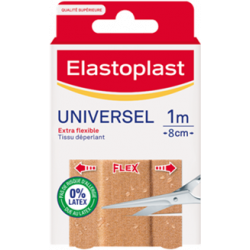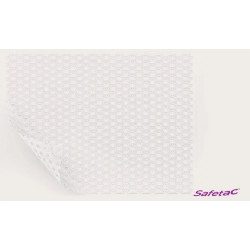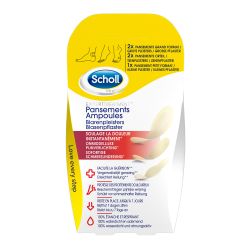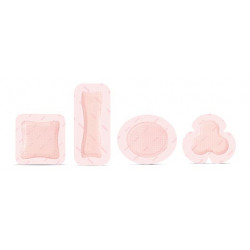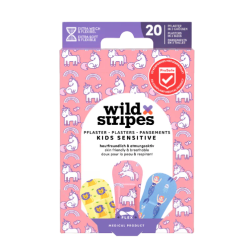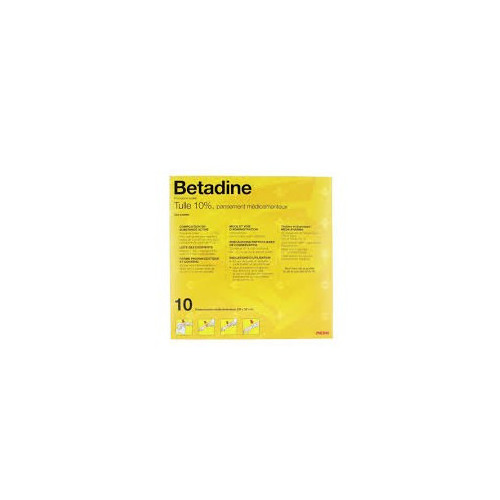



This is a medicine.
In the interests of patients, the online sale of medicines is strictly regulated in France.
Our site is backed by the Citypharma French Pharmacy (Paris 6) and has been approved by the Île de France Regional Health Agency since July1, 2014.
This medicine is an antiseptic containing iodine.
It is recommended :
- for superficial, small wounds or burns,
- in the adjunctive treatment of certain skin (and mucous membrane) diseases that are primarily bacterial
or susceptible to superinfection.
Data sheet
Specific References
- Antisepsis of superficial, small wounds or burns.
- Adjunctive treatment of skin and mucous membrane disorders that are primarily bacterial or susceptible to superinfection.
Note: Antiseptic agents are not sterilizing agents. They temporarily reduce the number of microorganisms.
For external use only.
- Open the protective sachet
- Apply the impregnated compress to the wound
- Cover with gauze or absorbent cotton
- Secure with a bandage.
- Apply every day or two.
ANSM - Updated on : 02/11/2017
BETADINE TULLE 10%, medicated dressing
2. QUALITATIVE AND QUANTITATIVE COMPOSITION 
Povidone iodine........................................................................................................................ 10 g
For an ointment spread at a rate of 3 g/dm2 on 47 g/m2 cotton gauze.
For full list of excipients, see section 6.1
.- Antisepsis of superficial, small wounds or burns.
-Adjunctive treatment of skin and mucous membrane disorders that are primarily bacterial or susceptible to superinfection
.Note: Antiseptic agents are not sterilizing agents. They temporarily reduce the number of microorganisms
.4.2. Dosage and administration 
external use only.
-Open the protective sachet
-Apply the impregnated compress to the wound
-Cover with gauze or absorbent cotton
. -Secure with a bandage.
-Apply daily or every other
day.This drug MUST NOT BE USED in the following situations:
- History of hypersensitivity to any of the constituents, particularly povidone. There are no cross-reactions with iodinated contrast media.
Intolerance reactions (anaphylactoid reactions) to iodinated contrast media or anaphylaxis to seafood are not contraindications to the use of BETADINE TULLE 10%
Premature babies and newborns (less than 1 month old).
- Prolonged use during the2nd and3rd trimesters of pregnancy.
- Breast-feeding is contraindicated in the event of prolonged treatment.
4.4 Special warnings and precautions for use 
Due
tothe transcutaneous resorption of iodine, the use of this product may lead to systemic effects (see section 4.8)
.These systemic effects, favored by the repetition of applications, are all the more to be feared when the antiseptic is used over a large surface area, under an occlusive dressing, on injured skin (notably burns), mucous membranes, or on the skin of premature babies or infants (due to the surface/weight ratio and the occlusive effect of layers at the breech level)
.Special care is required for regular applications to damaged skin in patients with renal insufficiency, particularly burn victims (see section 4.8
).Contraindicated in premature babies and newborns under 1 month of age. If essential, use in children under 30 months of age should be limited to a brief, limited application, followed by washing with sterile water
. -Do not apply BETADINE TULLE medicated dressing when foci are highly productive and oozing, or on recently grafted cancellous bone
. -Microbial contamination may occur as soon as antiseptic preparations are opened
.Precautions for use
Use with caution in all conditions likely to favor systemic passage, particularly in children under 30 months of age (see 4.4 Warnings and 4.3)
.This product is NOT recommended in association with mercury-derived antiseptics (see "Interaction with other drugs and other forms of interaction")
.4.5. Interactions with other drugs and other forms of interaction 
Erythema, phlyctenes, even mucocutaneous necrosis (formation of a caustic complex when iodine and mercury antiseptics are used simultaneously). Interaction depends on the skin stability of the organo-mercurial and on individual sensitivity
.Possible interference with thyroid function tests.
4.6. Fertility, pregnancy and lactation 
Pregnancy
Animal studies have shown no evidence of a teratogenic effect. In the absence of teratogenic effects in animals, a malformative effect in humans is not expected.
Indeed, to date,substances responsible for malformations in humans have been shown to be teratogenic in animals in well-conducted studies in two species
.Clinically, there are currently no sufficiently relevant data to assess a possible malformative effect of povidone-iodine when administered during the first trimester of pregnancy
.The fetal thyroid begins to bind iodine after 14 weeks of amenorrhea.
Iodine overload, which is very likely with prolonged use of this product after this term, may lead to biological or even clinical fetal hypothyroidism
.This is reversible if administered during the2nd trimester, but may lead to goiter at the end of pregnancy
. Consequently, as aprecautionary measure, it is preferable not to use this drug during the 1st trimester of pregnancy
.Prolonged use is contraindicated from
the2nd trimester onwards
.Occasional use should be considered only if necessary
.Iodine passes into breast milk in concentrations higher than maternal plasma.
Because ofthe risk of hypothyroidism in infants, breast-feeding is contraindicated in the event of prolonged treatment with this drug
.4.7. Effects on ability to drive and use machines 
The frequencies of adverse reactions have been classified as follows: very common (>1/10), common (≥1/100, <1/10), uncommon (≥1/1,000, <1/100), rare (≥1/10,000, <1/1,000), very rare (<1/10,000), undetermined frequency (cannot be estimated on the basis of available data)
.Immune system disorders
Undetermined Hypersensitivity
Undetermined Anaphylactic reaction: urticaria, angioedema, anaphylactic shock, anaphylactoid reaction
.Endocrine disorders
Indeterminate In the event of repeated, prolonged administration, diode overload may occur, leading to thyroid dysfunction, particularly in premature babies, infants and burn victims. Exceptional cases of hyperthyroidism have been reported*
.Undetermined Hypothyroidism **
Metabolism and nutrition disorders
Undetermined Metabolic acidosis ***
Skin and subcutaneous tissue disorders
Indeterminate Contact dermatitis (with symptoms such as erythema, bullae and pruritus) with burns on maceration
Not known Angioedema
Kidney and urinary tract disorders
Not known Acute renal insufficiency ***
* In patients with a history of thyroid disease (see section 4.4), after significant diode absorption, e.g. in the case of repeated use to treat wounds or burns over large areas.
** Hypothyroidism after prolonged or extensive use of povidone-iodine.
*** May occur through absorption of large volumes of povidone-iodine following exposure of large areas of skin or mucous membranes (e.g. treatment of burns).
Reporting suspected adverse reactions
It is important to report suspected adverse reactions after the drug has been authorized. It enables ongoing monitoring of the drug's risk/benefit ratio. Healthcare professionals report any suspected adverse reaction via the national reporting system: Agence nationale de sécurité du médicament et des produits de santé (ANSM) and the network of Regional Pharmacovigilance Centers - Website: www.ansm.sante.fr.
In the event of overdose, thyroid dysfunction may be observed.
Accidental massive ingestion may lead to severe liodine poisoning, and should be treated in a specialized facility. Symptoms include abdominal pain, anuria, collapse, pulmonary edema and metabolic abnormalities
.Treatment is symptomatic and adapted as required
.5.1. Pharmacodynamic properties 
Pharmacotherapeutic class: Antiseptics and disinfectants, ATC code: D08AG02.
Broad-spectrum bactericidal and fungicidal antiseptic for Candida albicans.
Antiseptic group: iodine derivatives.
Povidone-iodine is an iodophore, an organic complex with around 10% active available iodine
.Its spectrum of activity is that of iodine, released slowly and progressively:
-bactericidal in less than 5 minutes in vitro, on all bacteria,
-fungicidal
on yeasts.
Organic matter (proteins, serum, blood) reduces the activity of free iodine, the active form of this speciality
.Iodophores are unstable at alkaline pH.
Skin coated with povidone-iodine takes on a brown color that is easily removed with water.
5.2. Pharmacokinetic properties 
The available iodine in povidone-iodine can cross the skin barrier.
Elimination is mainly by the urinary route.
Under no circumstancescan povidone iodine alone be absorbed systemically
.In acute toxicity studies in mice, rats, rabbits and dogs, after systemic administration (oral, i.p., i.v.) toxic effects were observed only at excessively high doses, which are of no significance for local use of a povidone-iodine solution
.Thus, the LD50 in rodents is greater than 200 mg/kg of available iodine (equivalent to 20 ml per kg of a pure 10% solution of PVP-I) and intraperitoneally, greater than 30 mg of available iodine per kg (equivalent to 3 ml per kg of an undiluted 10% solution of PVP-I)
.Chronic toxicity
Subchronic and chronic toxicity studies have been carried out in rats, using povidone-iodine (10% available iodine) in the diet at doses of between 75 and 750 mg povidone-iodine per day per kg body weight for up to 12 weeks. After cessation of povidone-iodine administration, dose-dependent and reversible elevations in serum protein-bound diode and non-specific histopathological changes in the thyroid gland were observed. Similar changes also occurred in the control group which received diode-equivalent potassium liodide instead of povidone-iodine
.Chronic IP treatment in rats, starting at a dose of 5 mg/kg PVP-I, produced severe peritonitis with adhesion of intra-abdominal organs, leading to death
.Mutagenic and carcinogenic potential
PVP-I has no mutagenic potential.
No carcinogenicity studies have been conducted.
Reproductive and developmental toxicity
PVP-I is not teratogenic.
Macrogol 400, macrogol 4000, macrogol 6000, purified water.
Do not combine iodine/mercurials, as caustic compounds may result.
Iodine is an oxidizing agent (chemical incompatibilities) with reducing agents.
Inactivated by sodium thiosulfate (antidote possible).
Heat, light and alkaline pH (instability).
5 years.
6.4. Special storage precautions 
Store at temperatures not exceeding 30°C.
Keep away from heat.
Do not store opened sachet.
6.5. Nature and contents of packaging 
10 x 10 cm dressings in PE sachets.
10 dressings, 20 cm x 20 cm, in PE bags.
5 dressings of 10 cm x 10 cm in PE bags.
5 100 cm x 20 cm dressings in PE bags
.6.6. Special precautions for disposal and handling 
No special requirements.
7. MARKETING AUTHORIZATION HOLDER 
40-44 rue Washington
75008 Paris
8. MARKETING AUTHORIZATION NUMBER(S) 
- 321 940-8: 10 dressings, 10 cm x 10 cm, in PE bags.
-321 941-4: 10 dressings, 20 cm x 20 cm, in PE bags.
-553 064-2: 5 dressings, 100 cm x 20 cm, in PE bags
. -364 629-2: 5 dressings, 10 cm x 10 cm, in PE (expanded polypropylene) bags
.9. DATE OF FIRST AUTHORIZATION/RENEWAL OF AUTHORIZATION 
Date of first authorization: November 25, 1991
Date of last renewal: { DD Month YYYY}
Not applicable.
12. INSTRUCTIONS FOR THE PREPARATION OF RADIOPHARMACEUTICALS 
Not subject to medical prescription.
